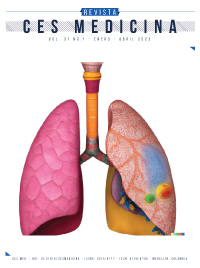Morel-Lavallée syndrome: successful surgical approach, a case report
DOI:
https://doi.org/10.21615/cesmedicina.7017Keywords:
Morel- Lavallée, seroma, trauma, deglovingAbstract
Introduction: Morel-Lavallée syndrome (MLS) is a tearing injury to the deep fascia and subcutaneous cellular tissue caused by shearing. The incidence of MLS has been estimated to be about 0.7% in patients who are victims of traffic accidents. The diagnosis is made by clinical examination, ultrasonography and magnetic resonance imaging. The syndrome has been classified into six imaging types according to chronicity, tissue composition and MRI appearance. These lesions have an infection rate of 46%, which can be life-threatening and therefore require timely management. Methods: 20-year-old male patient who suffers traffic accident as a cyclist, where he was dragged by a cargo vehicle generating friction burns of first, second and third degree in left hemibody associated with hematoma formation in the lower extremities that conditioned the appearance of SML, through the application of sclerotherapy, bursectomy and the novel technique of incisions in "grid" the resolution of chronic seromas was achieved. Results: after a judicious study of the clinical history, diagnostic images and physical examination it was possible to document that it was a case of a Morel Lavallée syndrome which is very rare in the population making its diagnosis difficult, however after a long time, multiple interventions by the surgical team and the establishment of hybrid techniques in the management of this pathology a very good result both functional and aesthetic was achieved. Conclusions: this case presents a novel technique in the treatment of SML in a private health center, with unusual occurrence in post-traumatic wounds, which despite early management can progress to its late stage and generate serious complications. Early diagnosis and proper management are important to avoid serious complications in patients with SML.
Downloads
References
Flato R, Passanante GJ, Skalski MR, Patel DB, White EA, Matcuk GR. The iliotibial tract: imaging, anatomy, injuries, and other pathology. Skeletal Radiol. 2017 May;46(5): 605–22.
Nickerson TP, Zielinski MD, Jenkins DH, Schiller HJ. The Mayo Clinic experience with Morel-Lavallée lesions: establishment of a practice management guideline. J Trauma Acute Care Surg. 2014 Feb;76(2):493–7.
Nekkanti S, Vijay C, Theja S, Shankar RR, Verma A. A Rare Case of Morel-Lavallée Syndrome Complicating an Anterior Dislocation of Hip Joint. J Orthop Case Reports. 2016 Oct;6(4):73–6.
Buyukkaya A, Güneş H, Özel MA, Buyukkaya R, Onbas Ö, Sarıtas A. Lumbar Morel-Lavallée lesion after trauma: a report of 2 cases. Am J Emerg Med. 2015 Aug;33(8):1116.e5-6.
Kim S-W, Roh S-G, Lee N-H, Yang K-M. Clinical experience of Morel-Lavallée syndrome. Arch Plast Surg. 2015 Jan 14;42(1):91–3.
Gummalla KM, George M, Dutta R. Morel-Lavallée lesion: case report of a rare extensive degloving soft tissue injury. Ulus Travma Acil Cerrahi Derg. 2014 Jan;20(1):63–5.
Durán-Martínez N, Torres-Valtierra E, Matus-Jiménez J, Arrieta Sandoval L. Síndrome compartimental de muslo y lesión de Morel-Lavallée. Acta Ortopédica Mexicana. 2012.
Molnar SL, Recarte A, Villafañe O, Lecumberri P, Csernátony Z. Morel-Lavallée syndrome of the tibia. BMJ Case Rep. 2011 Aug 4;2011.
Terlemez R, Erçalık T, Yılmaz F, Bertan H, Kuran B. A rare cause of thigh pain: Morel-Lavallée lesion. Turk J Phys Med Rehabil. 2018 Mar;64(1):80–2.
Pan J, Bredella MA. Imaging lesions of the lateral hip. Semin Musculoskelet Radiol. 2013 Jul;17(3):295–305.
Hegazi TM, Belair JA, McCarthy EJ, Roedl JB, Morrison WB. Sports Injuries about the Hip: What the Radiologist Should Know. Radiographics. 2016 Oct;36(6):1717–45.
Di Pietto F, Chianca V, Zappia M, Romano S. Articular and peri-articular hip lesions in soccer players. The importance of imaging in deciding which lesions will need surgery and which can be treated conservatively? Eur J Radiol. 2018 Aug;105:227–38.
Yablon CM, Pai D, Dong Q, Jacobson JA. Magnetic resonance imaging of the extensor mechanism. Magn Reson Imaging Clin N Am. 2014 Nov 1;22(4):601–20.
Saboo SS, Lin Y-C, Juan Y-H, Patel K, Weaver M, Sodickson A, et al. Magnetic resonance imaging for acute hip pain in the emergency department. Emerg Radiol. 2015 Aug;22(4):409–22.
Thomas S, Rupiper D, Stacy GS. Imaging of the patellofemoral joint. Clin Sports Med. 2014 Jul;33(3):413–36.
Latifi R, El-Hennawy H, El-Menyar A, Peralta R, Asim M, Consunji R, et al. The therapeutic challenges of degloving soft-tissue injuries. J Emerg Trauma Shock. 2014 Jul;7(3):228–32.
Knopp H., Martinez-Silvestrini J. Unique presentation of a Morel-Lavallée injury of the knee: A case report. PM and R. 2015;7(9):S200.
Sood A, Kotamarti VS, Therattil PJ, Lee ES. Sclerotherapy for the management of seromas: a systematic review. Eplasty. 2017 Aug 28;17:e25.
Coulibaly NF, Sankale AA, Sy MH, Kinkpe CVA, Kasse AN, Diouf S, et al. [Morel-Lavallée lesion in orthopaedic surgery (Nineteen cases)]. Ann Chir Plast Esthet. 2011 Feb;56(1):27–32.
Downloads
Published
How to Cite
Issue
Section
License
Copyright (c) 2023 CES Medicina

This work is licensed under a Creative Commons Attribution-NonCommercial-ShareAlike 4.0 International License.
Derechos de reproducción (copyright)
Cada manuscrito se acompañará de una declaración en la que se especifique que los materiales son inéditos, que no han sido publicados anteriormente en formato impreso o electrónico y que no se presentarán a ningún otro medio antes de conocer la decisión de la revista. En todo caso, cualquier publicación anterior, sea en forma impresa o electrónica, deberá darse a conocer a la redacción por escrito.
Plagios, duplicaciones totales o parciales, traduccones del original a otro idioma son de responsabilidad exclusiva de los autores el envío.
Los autores adjuntarán una declaración firmada indicando que, si el manuscrito se acepta para su publicación, los derechos de reproducción son propiedad exclusiva de la Revista CES Medicina.
Se solicita a los autores que proporcionen la información completa acerca de cualquier beca o subvención recibida de una entidad comercial u otro grupo con intereses privados, u otro organismo, para costear parcial o totalmente el trabajo en que se basa el artículo.
Los autores tienen la responsabilidad de obtener los permisos necesarios para reproducir cualquier material protegido por derechos de reproducción. El manuscrito se acompañará de la carta original que otorgue ese permiso y en ella debe especificarse con exactitud el número del cuadro o figura o el texto exacto que se citará y cómo se usará, así como la referencia bibliográfica completa.



